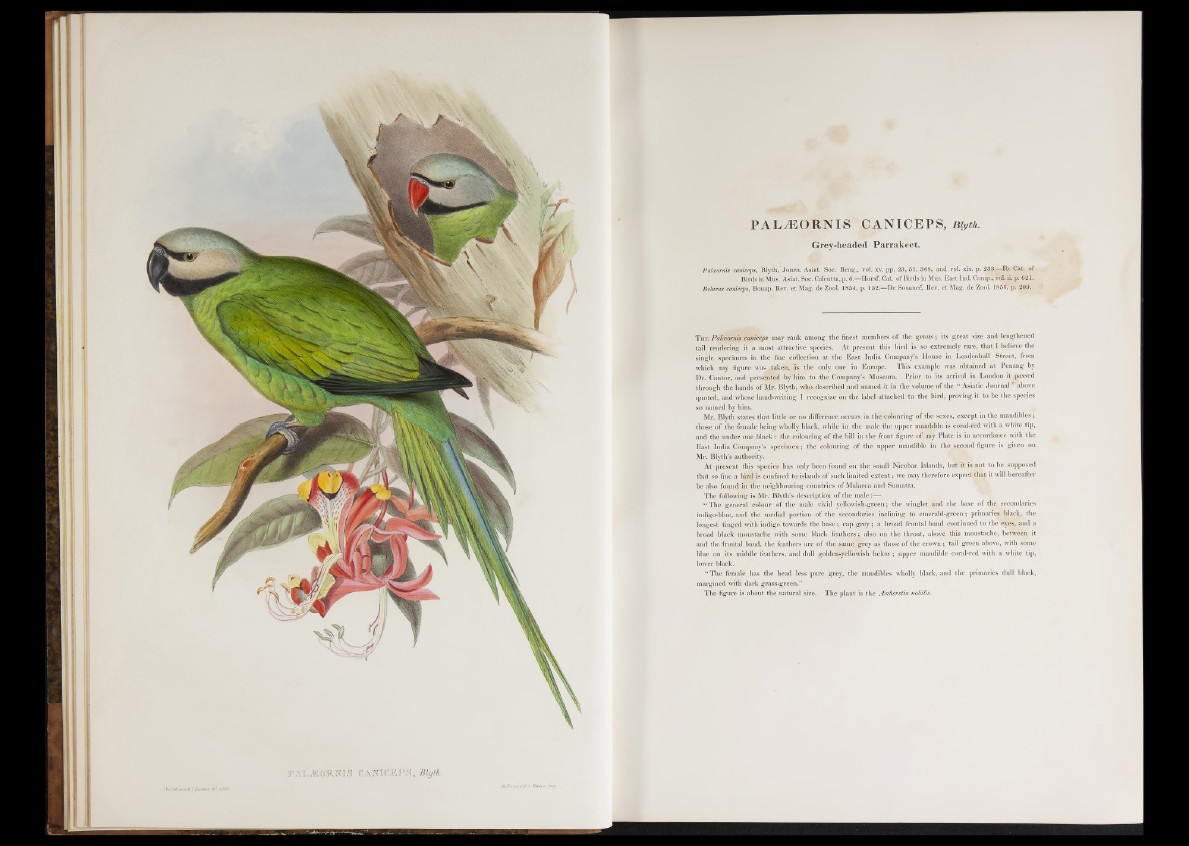
PALiEORNIS CANICEPS, myth.
Grey-headed Parrakeet.
Palceomis caniceps, Blyth, Journ. Asiat. Soc. Beng., vol. xv. pp. 23, 51, 368, and vol. xix. p. 233.—Ib. Cat. of
Birds in Mus. Asiat. Soc. Calcutta, p. 6.—Horsf. Cat. o f Birds in Mus. East Ind. Comp., vol. ii. p. 621.
Belurus caniceps, Bonap. Rev. et Mag. de Zool. 1854, p. 152,—De Sonance, Rev. et Mag. de Zool. 1856, p. 209.
T he Palceornis caniceps may rank among the finest members of the genus 5 its great size and lengthened
tail rendering it a most attractive species. At present this bird is so extremely rare, that I believe the
single specimen in the fine collection at the East India Company’s House in Leadenhall Street, from
which my figure was¡¿taken, is the only one in Europe. This example was obtained at Penang by
Dr. Cantor, and presented by*him to the Company’s Museum. Prior to its arrival in London it .passed
through the hands of Mr. Blyth, who described and named it in the volume of the “ Asiatic Journal ” iabove
quoted, and whose hand-writing I recognize on the label attached to the bird, proving it to be the species
so named by him.
Mr. Blyth states that little or no difference occurs in the colouring of the sexes, except in the mandibles;
those of the female being wholly black, while in the male the upper mandible is coral-red with a white tip,
and the under one black: the colouring of the bill in the front figure of my Plate is in accordance with the
East India Company’s specimen; the colouring of the upper mandible in the second figure is given on
Mr. Blyth’s authority.
At present this species has only been found on the small Nicohar Islands, buf it is not to be supposed
that so fine a bird is confined to islands o f such limited extent; we may therefore expect that it will hereafter
be also found in the neighbouring countries of Malacca and Sumatra.
The following is Mr. Blyth’s description of the male:—
“ The general colour of the male vivid yellowish-green; the winglet and the base of the secondaries
indigo-blue, and the medial portion of the secondaries inclining to emerald-green; primaries black, the
longest tinged with indigo towards the base; cap grey; a broad frontal band continued to the eyes, and a
broad black moustache with some black feathers ; also on the throat, above this moustache, between it
and the frontal band, the feathers are of the same, grey as those of the crown; tail green above, with some
blue on its middle feathers, and dull golden-yellowish below; upper mandible coral-red with a white tip,
lower black.
“ The female has the head less pure grey, the mandibles wholly black, and the primaries dull black,
margined with dark grass-green.”
The figure is about the natural size. The plant is the Amherstia nobilis.